Internet of Bio-Nano Things
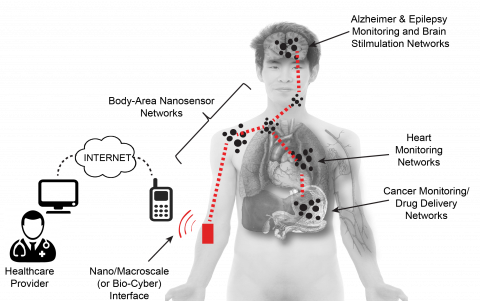 IoE aims to network everything around and even within us, which will lead to interfaces that are spread all the way from macro to nano scales. While several macro scale IoE implementations exist, the advances in nanotechnology and communication engineering paved the way for a proposal for Internet of NanoThings (IoNT) based on synthesized materials, electronic circuits, and interaction through electromagnetic waves.
IoE aims to network everything around and even within us, which will lead to interfaces that are spread all the way from macro to nano scales. While several macro scale IoE implementations exist, the advances in nanotechnology and communication engineering paved the way for a proposal for Internet of NanoThings (IoNT) based on synthesized materials, electronic circuits, and interaction through electromagnetic waves.
Although, IoNT systems can be used in a number of scenarios, their biocompatibility remains an issue for intra-body deployment. Thus, the Internet of Bio-Nano Things (IoBNT) proposal was brought forward. Under the IoE framework, IoBNT architecture revolves around establishing the capability to communicate and to network with biological systems, which can be used to perform operations such as intra-body sensing, actuation, and connectivity control. The quality and limitations of such communication networks, and their supported rates, can be quantified through an ICT study of these systems. Thus, a key motivation of an ICT study for a biological system is its eventual integration into the IoBNT framework, and thus, into the wider IoE framework.
Bio-Inspired Nanonetworks and ICT-Inspired Neuro-Treatment
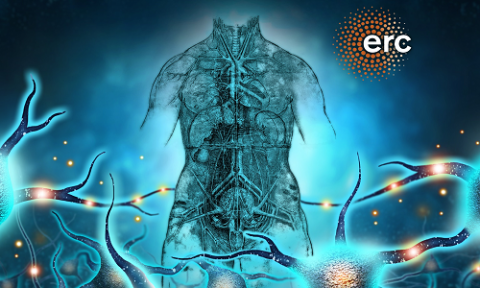
The human body is a communication network of nanonetworks composed of billions of nanomachines, i.e., cells, whose functionalities depend on molecular communications. Molecular communication is the key enabling communication methodology in biological mediums. This bio-inspired form of communication is happening within our living cells already and is coordinated in a complex and successful manner.
Under MINERVA project, we are modelling the nervous system through thorough investigation, both theoretical and experimental, of molecular communication channels involved within, experimenting to establish data communication interfaces with these systems, and working towards the design of a dedicated simulator for the nervous system. Ultimately, we aim to improve our understanding of this complex and grandiose molecular communication system and achieve novel ICT based treatment techniques for various nervous system disorders such as spinal cord injuries. Our scope involves the design of man-machine systems, design and development of artificial synapses towards artificial and hybrid neural networks and neuromorphic bioelectronics.
Terahertz Communication
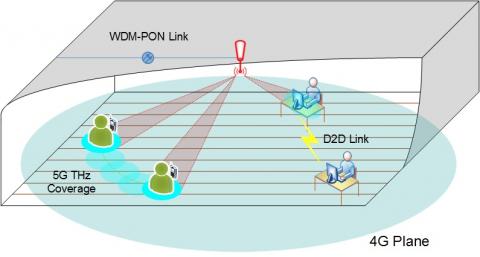
One of the major issues that IoE has to combat in terms of device connections is the scarcity of spectrum and in contrast an ever increasing demand for data rates. The main known methods for increasing data speed are clear: Increase the bandwidth or the spectral efficiency or decreasing the signaling overhead. Up to now, data speed has been increased by increasing the spectral efficiency in communication systems. However, to satisfy the needs of future data traffic, it’s not possible to reach to the data speed up to 10 Gb/s by only increasing the spectral efficiency. Thus, we require new enabling technologies such as terahertz (THz) communication to satisfy the consumer demand.
The frequency range 0.3-10 THz is defined as THz band, and THz band were initially being referred as “terahertz gap”. Utilization of THz band is essential to increase peak data rate to make room for the immense bandwidth demand of IoE. In THz communication, we envision the design for channel modeling, physical, MAC and network layer techniques, which will enable the usage of low THz band for communications in beyond 4G broadband communication systems. In our existing works, we have experimentally explored material and environment characterizations and performed statistical signal characterization of the THz channel to find important parameters such as pathloss coefficients in various bands of for 5G THz indoor channels. These studies have enabled us to propose designs for THz band transceivers in our most recent works. In future, we look to implement our designs and explore, both theoretically and experimentally, the MAC and network layer architectures for THz communications to meet the high data rate requirements from next-generation communication systems as part of the wider IoE framework.
Cognitive Radio Sensor Network
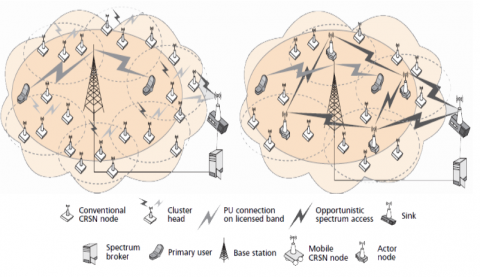 Many applications of IoE will depend on Wireless Sensor Networks (WSN) because of lower data rate, cost and form factor requirements. These applications thus cannot use THz communication. Currently, WSNs exclusively operate over unlicensed bands. Significant increase in the applications that use these bands brings about the coexistence problem. Hence, WSN needs additional capabilities to combat the interference incurred by the other applications. A promising solution is to use the cognitive radio (CR) technology to arm the sensor nodes with opportunistic spectrum access (OSA) capability. Towards this end, cognitive radio sensor network (CRSN) is a recently emerging paradigm that aims to utilize the unique features provided by CR concept to incorporate additional capabilities to WSN to sense event signals and collaboratively communicate their readings over dynamically available spectrum bands in a multi-hop manner, ultimately to satisfy the application-specific requirements. This enables the use of the most suitable channel for application-specific requirements and significantly reduces power consumption.
Many applications of IoE will depend on Wireless Sensor Networks (WSN) because of lower data rate, cost and form factor requirements. These applications thus cannot use THz communication. Currently, WSNs exclusively operate over unlicensed bands. Significant increase in the applications that use these bands brings about the coexistence problem. Hence, WSN needs additional capabilities to combat the interference incurred by the other applications. A promising solution is to use the cognitive radio (CR) technology to arm the sensor nodes with opportunistic spectrum access (OSA) capability. Towards this end, cognitive radio sensor network (CRSN) is a recently emerging paradigm that aims to utilize the unique features provided by CR concept to incorporate additional capabilities to WSN to sense event signals and collaboratively communicate their readings over dynamically available spectrum bands in a multi-hop manner, ultimately to satisfy the application-specific requirements. This enables the use of the most suitable channel for application-specific requirements and significantly reduces power consumption.
Internet of Energy Harvesting Things
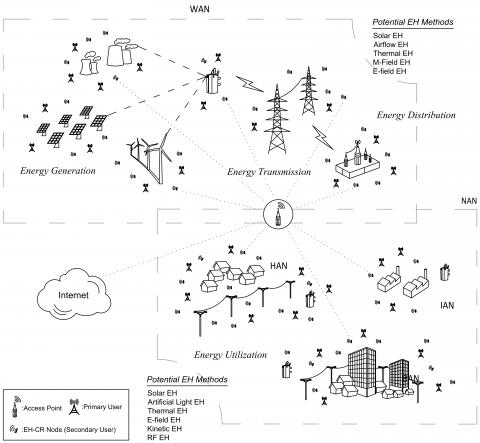 Internet of Things (IoT) is a promising candidate in realizing efficient monitoring and control of physical world whenever and wherever needed. This vision necessitates sensors to be deployed in excessive numbers to guarantee high-accuracy data collection across a large event area. However, replenishing batteries of thousands, maybe millions of devices is highly challenging. In order to resolve this issue, Internet of Energy Harvesting Things is envisioned. Although the preliminary studies on adapting energy harvesting (EH) technology to IoT domain gave satisfactory results, the need for more robust, reliable and efficient harvesting procedures has recently emerged.
Internet of Things (IoT) is a promising candidate in realizing efficient monitoring and control of physical world whenever and wherever needed. This vision necessitates sensors to be deployed in excessive numbers to guarantee high-accuracy data collection across a large event area. However, replenishing batteries of thousands, maybe millions of devices is highly challenging. In order to resolve this issue, Internet of Energy Harvesting Things is envisioned. Although the preliminary studies on adapting energy harvesting (EH) technology to IoT domain gave satisfactory results, the need for more robust, reliable and efficient harvesting procedures has recently emerged.
Notwithstanding the performance of any EH method, taking advantage of diverse sources shows great potential in powering wireless devices due to reduced variance and increased rating at power output. Considering this, we broadened the research field by coining the term of Internet of Hybrid Energy Harvesting Things taking the reliability in power provisioning a step further. After that, we implemented our gains on multi-source EH in the diverse domains of IoT. In that stage, we envisioned Energy Neutral Internet of Drones to provide advanced connectivity by overcoming energy limitations. Joint utilization of wireless power transfer (WPT) and multi-source EH widened our horizons, whereby we came up with Internet of Wireless-powered Things enabling completely untethered and self-sustaining operations in IoT domain. Finally, Internet of Energy Harvesting Cognitive Radios has been envisioned to diminish two major problems of IoT, which are energy and spectrum scarcity. We further elaborate on these and related fields to fully alleviate the energy-based limitations of IoT networks/services and build Next-generation Internet of Energy Harvesting Things, which are self-sufficient, spectrum-aware and totally untethered.
Internet of Space
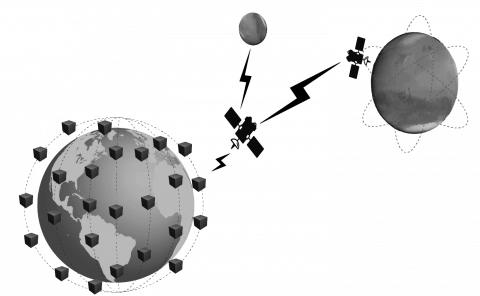 With the developments in the space industry, Internet of Space (IoS) is a new paradigm emerging under Internet of Everythings, enabling interplanetary and suborbital networks. Right now, more than 2000 satellites are orbiting the Earth and many more launches are being planned, making suborbital networks inevitable. Moreover, countless landings on extra-terrestial objects and the possibility of terraforming some of them make the Internet of Space vision imminent. IoS vision connects all suborbital devices and outer space objects to Internet. Due to the sheer distance between networking parties, standard IP-based communication techniques may not be enough to assure seamless connection for interplanetary networks. Therefore, IoS includes unique challenges and physical limitations.
With the developments in the space industry, Internet of Space (IoS) is a new paradigm emerging under Internet of Everythings, enabling interplanetary and suborbital networks. Right now, more than 2000 satellites are orbiting the Earth and many more launches are being planned, making suborbital networks inevitable. Moreover, countless landings on extra-terrestial objects and the possibility of terraforming some of them make the Internet of Space vision imminent. IoS vision connects all suborbital devices and outer space objects to Internet. Due to the sheer distance between networking parties, standard IP-based communication techniques may not be enough to assure seamless connection for interplanetary networks. Therefore, IoS includes unique challenges and physical limitations.
Internet of Vehicles
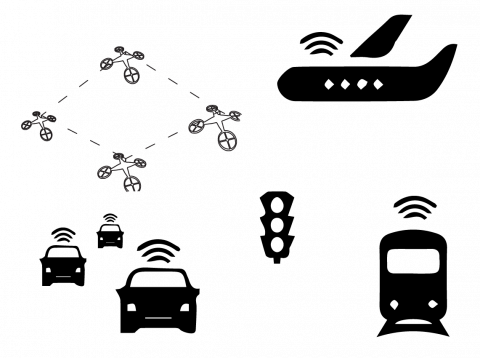 The recent census data suggests there are currently more than one billion motor vehicles on road. With their ever increasing number, they require constant interaction with each other, drivers, passangers and the road. Internet of Vehicles is a revolutionary concept under Internet of Everything, connecting people, vehicles, road and sensors. IoV includes both centralized and decentralized components, where central mechanisms are responsible for policy making and the instantaneous decisions are taken at the edges. All components of IoV uses their own communication, storage and learning capabilities; enabling fully autonomous, evolving networks. IoV will constantly monitor the road, traffic load, weather conditions and perform real time decisions. Achieving a fully functional IoV will reduce the carbon footprint of transportation, lower the accidents and casualties, possibly saving millions of lives and preventing tens of millions of injuries per year. IoV vision will also allow people to spend less time on the road with minimal involvement with the driving.
The recent census data suggests there are currently more than one billion motor vehicles on road. With their ever increasing number, they require constant interaction with each other, drivers, passangers and the road. Internet of Vehicles is a revolutionary concept under Internet of Everything, connecting people, vehicles, road and sensors. IoV includes both centralized and decentralized components, where central mechanisms are responsible for policy making and the instantaneous decisions are taken at the edges. All components of IoV uses their own communication, storage and learning capabilities; enabling fully autonomous, evolving networks. IoV will constantly monitor the road, traffic load, weather conditions and perform real time decisions. Achieving a fully functional IoV will reduce the carbon footprint of transportation, lower the accidents and casualties, possibly saving millions of lives and preventing tens of millions of injuries per year. IoV vision will also allow people to spend less time on the road with minimal involvement with the driving.

